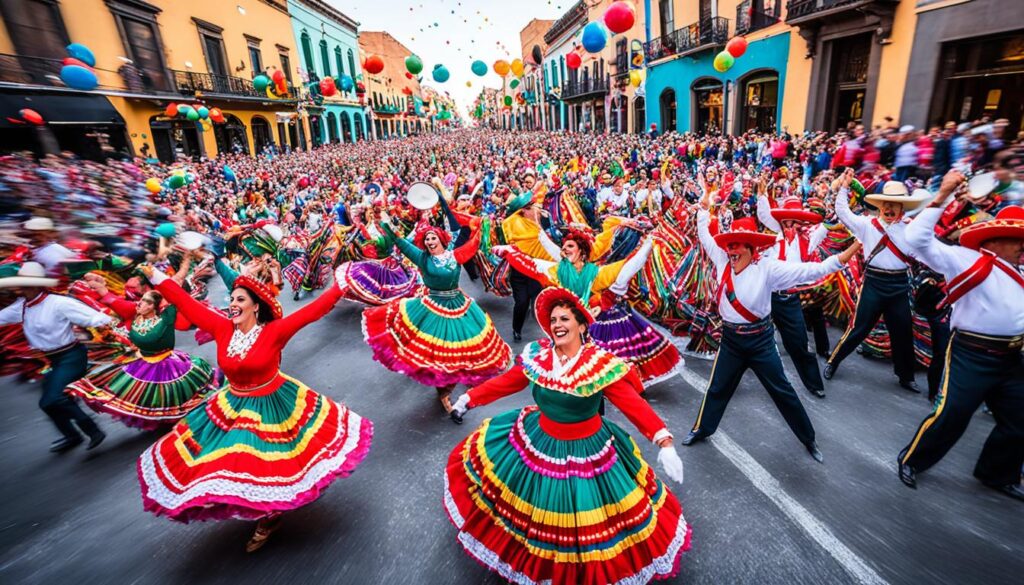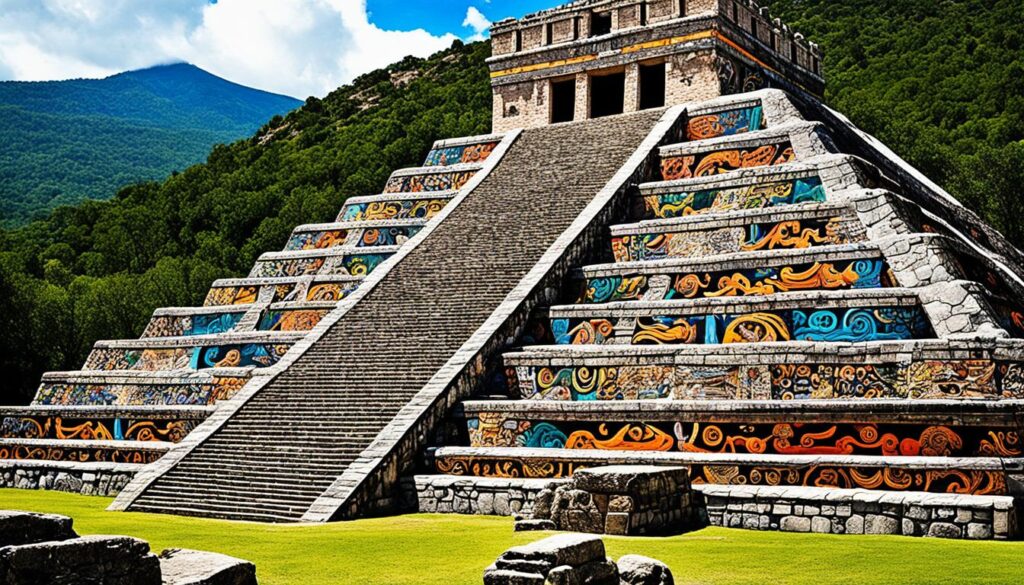I am a participant in the Amazon Services LLC Associates Program, an affiliate advertising program designed to provide a means for sites to earn advertising fees by advertising and linking to Amazon.com and affiliated sites. Privacy Policy
Cultural Traditions in Mexico: Exploring Vibrant Heritage
What makes Mexico such a special place? It’s not just the ancient ruins or the bright Dia de los Muertos. Mexico is a mix of many cultural influences, lively expressions, and strong customs. Let’s take a closer look at the tapestry of traditions that brings Mexico to life.

Key Takeaways
- Discover the enduring legacy of Mexico’s ancient civilizations, including the Olmecs, Teotihuacanos, Maya, and Aztecs.
- Explore the captivating influence of Spanish colonial architecture, art, and literature on Mexico’s cultural landscape.
- Immerse yourself in the vibrant celebrations of Dia de los Muertos and Cinco de Mayo, two of Mexico’s most iconic cultural traditions.
- Savor the diverse flavors of Mexican cuisine, from regional specialties to the use of indigenous ingredients.
- Appreciate the artistry and craftsmanship of Mexico’s traditional arts and crafts, from intricate pottery to vibrant textiles.
Best Wireless Portable Charger Buy Here
Ancient Civilizations: Foundations of Mexican Culture
Mexico’s history is full of ancient peoples that influenced its culture. From the Olmecs to the Aztecs, these groups played a big role in shaping Mexico’s identity. They still capture the interest of both scholars and tourists today.
Olmecs: The Mother Culture
The Olmecs, known as the “Mother Culture,” lived from 1500 to 400 BCE. They are famous for their huge stone heads. They also advanced urban planning, farming, and the Mesoamerican ballgame. Their work set the stage for future cultural traditions in the region.
Teotihuacan: The City of Gods
Teotihuacan was a big city just north of current Mexico City. It was a major hub in the ancient world. This “City of Gods” once housed over 100,000 people. Its clean grid layout and great structures, like the Pyramid of the Sun, amazed everyone.
Maya: Masters of the Cosmos
The Maya lived in southern Mexico and beyond. They were well-known for their complex writing, deep astronomy knowledge, and detailed calendars. They built famous cities like Tikal and Chichen Itza. Chichen Itza is now one of the New 7 Wonders of the World.
Aztecs: Empire of the Eagle Warriors
The Aztec Empire’s heart was in Tenochtitlan, today’s Mexico City. They were a military, urban, and cultural power. In Tenochtitlan, they built temples, markets, and canals. This showed their impressive engineering skills.

Spanish Colonial Influence and Legacy
Mexico’s history is closely linked with the Spanish colonial era from the early 16th century. Spanish architecture, art, and language left their mark on many Mexican cities. Oaxaca, Guanajuato, and San Miguel de Allende reflect this with their colonial buildings and streets.
Architecture and City Planning
The Spanish left a clear mark on Mexico’s architecture and city design. Many colonial cities have a grid layout, complete with plazas and cathedrals. These designs show the Spanish influence on Mexico’s urban planning and architecture, such as the majestic Catedral Metropolitana in Mexico City.
The Spanish style is also evident in Mexico’s churches and government buildings. The ornate baroque designs show how the Spanish aesthetic became part of Mexico’s building style.
Art and Literature
The Spanish colonial era deeply influenced Mexican art and literature. New art forms, like colorful church murals, and unique literary works emerged, shaping Mexican culture. These traditions continue to be celebrated, both in Mexico and worldwide, for their creativity and meaning.
Religion and Syncretism
The Spanish introduced Catholicism to Mexico, which mingled with indigenous beliefs. This mix created a special spirituality seen in Mexican culture today. This blend is visible in Mexico’s religious celebrations, community events, and artwork.

What are the cultural traditions in Mexico?
Mexico is well-known for its colorful festivals and events. These highlight the deep traditions of the country. They come from many influences, including native customs and religious practices. This mix of traditions has grown over hundreds of years.
Festivals and Celebrations
Mexicans love to join together for a variety of festivals. Each one has special customs and traditions. These events are not only fun but also keep the country’s culture alive. They attract people with music, dance, and unique clothes.
Day of the Dead (Día de Muertos)
The Day of the Dead is a well-known Mexican tradition, recognized by UNESCO. Families celebrate by creating colorful altars and marching in processions. They also have big feasts. This tradition mixes old native practices with newer Catholic influences. It makes for a touching and special time.
Cinco de Mayo
Cinco de Mayo is important in Mexican culture because it marks a historic victory over the French. Celebrated with parades and music, it also includes enjoying Mexican food and drinks. This event highlights Mexico’s strength and rich cultural background.
Traditional Arts and Crafts
Mexican art and crafts speak to the nation’s vivid cultural heritage. They include detailed pottery, colorful textiles, and finely made jewelry. These are examples of the rich traditional arts and crafts all over Mexico.
Oaxaca, Taxco, and San Cristobal de las Casas are famous. They are known for their skilled artisans. These artisans keep the traditional crafts alive, drawing inspiration from indigenous cultures and pre-Hispanic heritage.
| Traditional Mexican Art Forms | Regional Specialties |
|---|---|
| Pottery Textiles Jewelry Woodcarving Metalwork Basketry | Oaxacan folk art Taxco silver jewelry San Cristobal de las Casas indigenous crafts Michoacán artisanal pottery Chiapas woven textiles |
These Mexican folk art forms aren’t just beautiful. They are essential for showcasing the country’s lively cultural traditions. They also help indigenous communities keep their unique artistic heritage alive.
Culinary Heritage: A Delectable Journey
Mexican food is famous for bold tastes, many ingredients, and special ways of cooking. It’s known and loved all over the world. From the busy streets with their tasty tacos to Oaxaca’s deep mole sauces, each part of Mexico has its own food traditions. This shows the rich history of Mexico through its food.
Regional Cuisines
In Mexico, each area has its unique food. For example, the north has dishes like carne asada and machaca. These are known for being filling and delicious. Meanwhile, the south uses Mayan influences to make dishes with rich mole sauces and tamales. The central part of Mexico is famous for tacos al pastor, while the coast offers fresh seafood like ceviche and aguachile.
Indigenous Ingredients
The heart of Mexican cuisine lies in its indigenous ingredients like corn, chili peppers, and avocados. These have been essential for hundreds of years, adding special tastes and health benefits to classic dishes. The skill of using these ingredients shows the creativity and knowledge of Mexico’s native people in cooking.
Traditional Beverages
Drinks are a big part of Mexican food culture too. Tequila, mezcal, and pulque are some of the traditional beverages. They each have their unique tastes and are made using special methods from different regions of Mexico. Together, these drinks and Mexican food make a perfect match, offering diners a variety of flavors to enjoy.
Music and Dance: Rhythms of Mexico
Music and dance are key elements of Mexican life. They show the various cultural influences and long history of the country. From the famous mariachi to the beautiful steps of folk dances, Mexico’s music and dancing have won hearts around the globe.
Mariachi and Regional Styles
Mariachi music is Mexico’s heart and soul. Its catchy tunes and special instruments are loved worldwide. Mariachi bands, with their guitars, violins, trumpets, and Cowboys, are easily recognized. Mexico also boasts many other music styles that vary by region. For example, the lively norteño from the north and the heartfelt son from the south.
Folk Dances and Traditions
Traditional dances keep Mexico’s culture alive. Dances like the famous jarabe tapatio (Mexican hat dance) and the danza de los voladores (the dance of the flyers) are still performed. These shows are full of live music and bright outfits. They show the mix of Native and Spanish cultures in Mexico. The jarabe tapatio is known for its elegant moves, and the danza de los voladores for its daring feats. Both dance styles are a big part of Mexico’s cultural pride.
Conclusion: Preserving Mexico’s Vibrant Heritage
Mexico is famous for its vibrant heritage, from old civilizations to new arts and festivals. It’s key to keep these traditions alive for future generations. Both visitors and locals can learn and love Mexico by experiencing its rich culture.
By maintaining its old, new, and colonial aspects, Mexico’s vibrant heritage stays strong. People worldwide feel drawn to its ancient ruins and colorful celebrations. These traditions tell unique stories and must be protected for years to come.
When in Mexico, exploring its cultural traditions adds meaning to your trip. You’ll see the detailed work of local artists and taste the flavors of the land. These experiences highlight Mexico’s beauty and show the world its creative spirit.
FAQ
What are the cultural traditions in Mexico?
Mexico has a wide range of cultural traditions known worldwide. This includes lively festivals, ancient cultures, indigenous rituals, and more. The traditions show Mexico’s rich history and diverse culture.
What are some of the major festivals and celebrations in Mexico?
In Mexico, people celebrate events like the Day of the Dead and Cinco de Mayo in unique ways. The Day of the Dead is a special time to remember loved ones who have died. Cinco de Mayo remembers a historic victory over the French by the Mexican Army.
What are the ancient civilizations that have influenced Mexican culture?
The Olmecs, Teotihuacan, Maya, and Aztecs are ancient Mexican civilizations we still talk about today. They advanced in many areas like city planning, farming, and religion. Their knowledge has shaped Mexican culture in many significant ways.
How has the Spanish colonial influence shaped Mexican culture?
The Spanish brought their culture to Mexico when they colonized it in the 1500s. Their influence can be seen in Mexican art, architecture, and religious beliefs. The combination of the Spanish and indigenous aspects created a unique Mexican culture.
What are some examples of traditional Mexican arts and crafts?
Traditional Mexican arts and crafts include fine pottery, colorful textiles, and artisanal jewelry. They often reflect Mexico’s indigenous roots and ancient cultures. These skills are passed down through generations, keeping traditions alive.
What are the key elements of Mexican cuisine?
Mexican food is famous for its exciting flavors and ingredients like corn and chili peppers. These elements have been part of Mexican cooking for a long time. Besides food, there are also famous drinks like tequila that are part of Mexican culture.
What are the important musical and dance traditions in Mexico?
Mexican music and dance are vital to its culture. Genres like Mariachi are known worldwide. Also, traditional dances like the jarabe tapatio keep Mexico’s heritage alive. These art forms show the country’s diverse influences.
I am a participant in the Amazon Services LLC Associates Program, an affiliate advertising program designed to provide a means for sites to earn advertising fees by advertising and linking to Amazon.com and affiliated sites. Privacy Policy
